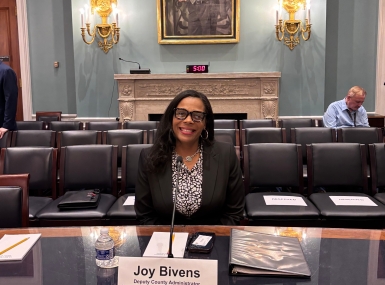Counties transform, modernize human services delivery systems
Author
Upcoming Events
Related News

Key Takeaways
County human services delivery systems are a critical touchpoint for children and families, especially those who are experiencing economic hardship and the negative impacts of the coronavirus (COVID-19). County-delivered human services provide critical supports and a safety net for moving individuals, children and families out of poverty and improving their immediate and long-term health outcomes.
However, residents in need often interface with multiple programs and services that operate in silos with different program standards and eligibility rules. This experience can be stressful and retraumatize families who are already in crisis. As families navigate the intricate maze of systems and application standards and forms, county leaders are exploring policy and technical solutions for transforming the human services delivery system in a way that supports the whole needs of families.
Local government leaders across the nation have witnessed firsthand some of the inequities and gaps that already exist in child and family service systems and are working diligently to adopt novel approaches to address disparities exacerbated by the pandemic.
Human services transformation is a key solution for improving the customer experience and helping families navigate and access the necessary supports that strengthen their pathway to gainful employment and social and economic mobility. County leaders have found that successful transformation occurs through the promotion and implementation of existing and new polices and resources that promote integration and coordination across the human services enterprise.
Why human services transformation matters to counties
While balancing numerous administrative responsibilities, counties deliver essential services to ensure healthy, safe and vibrant communities across the United States. Counties invest over $63 billion annually in federal, state and local funds in human services while serving as the frontline safety net. They also employ over 257,000 county human services workers across the country who deliver these critical services to residents.
County governments are responsible for administering federal human services programs in at least nine states — California, Colorado, Minnesota, New York, North Carolina, North Dakota, Ohio, Pennsylvania, Virginia. Federal programs include the Temporary Assistance for Needy Families (TANF), Supplemental Nutrition Assistance Program (SNAP), Child Care and Development Block Grant and other programs. They are vital components of a human services system but responsibilities vary and can either fall under a county’s purview or the authority of the state. Regardless of their authority, counties possess the capability to connect and coordinate with other public sector systems such as housing, disability, health and behavioral health services to address the whole needs of families.
Oftentimes, children and families come to the front door of downstream systems (e.g. homelessness, emergency rooms, in-patient behavioral and health care facilities, out of home placement and other entities) to receive access to services addressing root cause issues related to poor health conditions, family challenges, behavioral health needs, criminal activity, unemployment and other barriers.
Although the traditional health and human services models tend to focus on transactional approaches to eligibility determination and service delivery and outputs rather than outcomes, counties can adopt meaningful strategies and scalable approaches to identify high-risk factors, improve the customer experience, catch families early and move them upstream.
Increasingly, counties are recognizing the complexities of managing and operating within a soiled system in addition to the multiple funding streams and program rules that support them. They are also recognizing that these challenges have inevitably and historically created barriers to achieving cross-systems collaboration. As a result, counties can deploy “no wrong door,” person-centric models that meet residents where they are rather than in a siloed operation. This presents an opportunity to dismantle outdated legacy systems and embrace modernized data and information technology systems that speak to one another. To promote efficiency, counties can also invest in software and mobile applications that adopt streamlined standards and processes for service delivery. They can also leverage financing strategies that blend and braid a variety of funding streams to maximize resources for a transformative system.
How counties are transforming human services delivery systems
Many counties across the nation have shown dedication to advancing human services systems transformation to achieve better outcomes for residents and communities. For example, Buncombe County, N.C. has an integrated health and human services system that coordinates services across public and private sectors to improve outcomes for children and families.
In 2013, the county earned a NACo Achievement Award for its integration initiative, which has bridged gaps between government programs and service providers cutting across multiple settings such as school, home and the community. The county has leveraged federal, state and local polices and funding to establish a call center and in-person one-stop shop with automated options for consumers to easily navigate and apply for services, improve the workforce and promote person-centered service delivery, launch a new integrated information technology system for income eligibility programs and create community service navigators to strengthen residents’ connection to vital supports involving behavioral health, child care, public health and dental services, child welfare, child support, veterans services, housing and homelessness resources, legal services and transportation.
A local integrated service design that leverages a “no wrong door” approach can promote preventive, whole family strategies leading to improved outcomes. These types of systems often include coordinated case management, fewer points of entry for clients, co-located services and streamlined eligibility and enrollment systems leading to fewer barriers to care, slower disability progression, less emergency and crisis care, reduced inpatient and institutional care, and lowered costs.
In 2010, the San Diego County Board of Supervisors adopted the “Live Well San Diego” vision of a region that is building better health, living safely and thriving. It aligns the efforts of individuals, organizations and government to help all 3.3 million San Diego County residents live well.
San Diego County’s human services transformation story involves a paradigm shift in service delivery, promoting a “large-scale, social movement for prevention, wellness and whole person care.” Nevertheless, the scale of the system and the costs of service delivery are major factors in the appetite for new models. This presents counties with an opportunity to learn from other local leaders and explore policy, systems and funding mechanisms that improve service delivery and outcomes for individuals, children and families.
What can counties do to transform their systems?
NACo recently launched its “Transforming County Human Services Network,” bringing together county human services agency leaders and appointed and elected officials who are responsible for shaping policies and systems driving public human services programs such as the TANF, SNAP, child-care assistance, housing and homelessness and child welfare programs.
This community of practice allows leaders to network and engage in peer learning and educational activities that share innovative models and best practices for modernizing and integrating county-based human services systems. The goal of the network is for county leaders to gain strategies for advancing racial equity, reducing multigenerational poverty and working through regulatory hurdles by leveraging policy solutions that drive systems change.
Regardless of your role or position, there will be a resource for you! We encourage you to join the network of leaders who are dedicated to making bold change in their county. For more information visit https://www.naco.org/transforming-county-human-services-network.

Attachments
Related News

U.S. Department of Agriculture announces reorganization
On July 24, U.S. Secretary of Agriculture Brooke Rollins announced a major reorganization of the U.S. Department of Agriculture (USDA) that will relocate thousands of federal employees, restructure regional offices and consolidate administrative services and operations. The changes are expected to reduce USDA’s footprint in Washington, D.C. and shift more personnel to regional hubs across the country.

County officials shed light on childhood education and care
Inadequate childcare causes American workers to lose between 9 million and 26 million hours of work in any given week and has a negative impact on children’s development.

